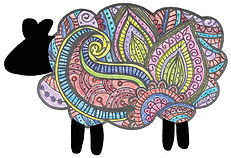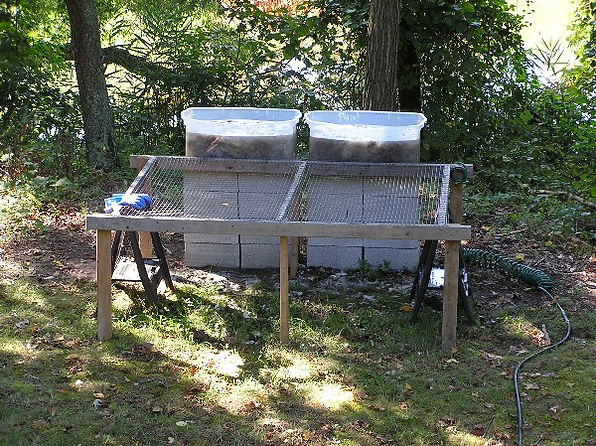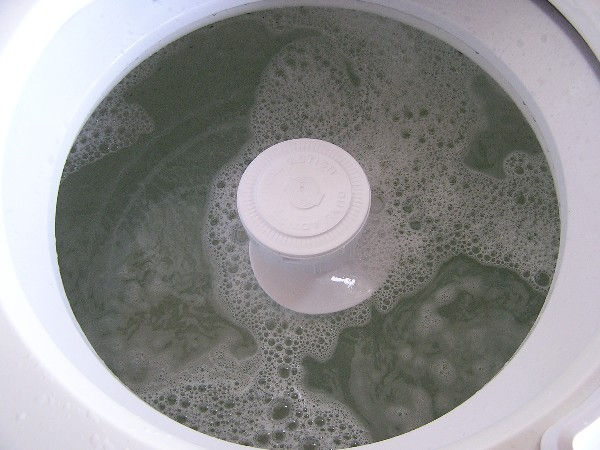Ten Good Sheep

authentically artistic & certifiably cute since 1998
Ten Good Sheep's
world famous (it really is!) wool washing tutorial

The Prelude...
Part 1:
"I wish the sheep shearer would hurry up and get here. It rained yesterday and the sheep are cleaner than they've been in weeks."
Part 2 (nine months later):
"I'm glad we took those shearing classes. Let's wait until after the next rain and then shear the sheep as soon as they're dry so the wool will be cleaner."
Part 3 (nine months even later):
"Huh, wait a minute, rain is nothing more than a lot of cold water...
hmmmmmmmm."
Ok...so we were slow learners.
We're serious about washing wool! Ready to get started?
You'll want some infrastructure for your wool washing career to run smoothly. You will need:

Your very own wool washing table.
Our table uses rabbit wire for the top (about 1/4" wire mesh).
Note the handy hook for your hose...you'll need a hose too.
(Or if you're set up for it, you can collect rainwater and use that.)
Also, note the concrete blocks in the picture at the top of this tutorial.
They're used for washstands. If you're going to wash a lot of wool, set these up.
You'll thank us later.
Set your table up where a lot of water hitting the ground won't matter.
Or, re-use your wool washing water in your garden by catching it beneath the table.
It's yucky, but your plants won't mind.
Depending on when you schedule your shearing you can use less water. Let the rain do the first washing before you shear, but make sure your sheep is fully dry before shearing.
And you'll need:

A wash tub (relatively heavy duty plastic - it'll be holding a lot of water).
And you'll need a dirty fleece. This one is natural charcoal colored Romney.
Wait til you see it when we're done. Gorgeous!
And you'll need:

Umm, gloves. You need rubber gloves.
And maybe just a bit of white wine.
Ok, let's get down to business!
Fill your washtub about 2/3 full of cold water from your hose.

The wooden board is under the tub because we don't have the concrete block wash stands set up in the middle of the backyard. This will do in a pinch, but the blocks are better.
As your washtub is filling, unroll your fleece and take a good look .
If your fleece has not been skirted, do it now.
Tear away and belly, neck, britch and generally yucky stuff
Don't throw it away though, use it for a long lasting weed barrier under mulch.

Use the washing table as a trampoline for your remaining fleece.
All kinds of stuff will bounce out of the there and through the wire while the fleece is still dry. Give it a good hard couple of throws on top of the table.
Depending on the size of your fleece, divide it into manageable sections.
We separated this one into 2 pieces.
Some of our own sheep have enormous fleeces and we divide them into thirds.
You can wash a substantial amount at one time, but don't crowd it too much.
You'll develop a feel for how much is a good amount.

Here is 1/2 of the sticky fleece. It's been in storage for 2 years!
It was well skirted before storage so everything is ok.
Don't store unskirted fleeces. You'll be sorry.
Into the cold water we go...

Push your wool down into the water gently until it's saturated.

Then you can walk away from it for a while if you want to.
10 minutes or 10 hours...we've done both. Covering it is not a bad idea.

See? Look at all of the dirt floating its way out of the fleece all by itself.
Now we're going to work the wool a bit.
Don't be afraid to move it around, but you don't want to be too aggressive about it either.
We want to let the wool swish through the water, so grasp it and bring it up...

and then down. You only need to do it a few times and very gently.

When the water is fully saturated with sheep dirt...
SWOOSH!
You'll be amazed at the difference in your fleece already.

As a side note:
If you see bubbles on the ground at this point, it's because the fleece is holding sheep sweat and lanolin (aka - suint). Since a lot of this is water soluble, when combined with the water, it makes (sort of/kind of) its own natural soap. Hence the bubbles. Sheep bubbles!
Next, gather it up...

And squeeze. Then squeeze again.

ROUND 2
You can already see quite an improvement in your fleece, can't you?
Refill you washtub and get ready for more of the same exercise
Let your fleece drape back into the water...no need to bunch it up.
Let it float for a bit and then a little more up/down, up/down.
Let the water swish through the fleece.
There's a difference between allowing the wool to swish and agitating.
Don't agitate...swish.


Notice the water...murky but not disgusting.
We're making progress!

When you think this round of water has done the best it can do...
SWOOSH!

Then squeeze it like you really mean it!

Now we have a fork in the road.
What did your second wash look like? It could be enough.
But for this particular fleece we're going for...
ROUND 3
If you're doing another round, you know what to do by now.
Refill your washtub and lay in your squeezed out fleece.
Let it sit, or not. And then a little more up/down, up/down.
Light swishing gets the job done, and you don't have to do it a lot.
Time to SWOOSH!
Check out the clarity of the water still in the tub.
That works for us...outside work is done!

Let's go inside...
Now that the majority of gross dirt is out of your fleece, it won't hurt your washer (or plumbing) to give it a hot soak.
Yes, the wool is still damp from squeezing out the cold water.
No, it won't instantly felt in the hot water.
And you're going to be turning OFF the washer so NO AGITATION will be happening, but more on this soon.
Next...
With your fleece OUTSIDE of the washer in a bucket or other container,
fill your washer (or outside tub if you have a computerized washing machine - see notation a few sections down about computerized washing machines vs. older fashioned manual washing machines.) with hot water. No soap yet, just water.

Once the washer is full of hot water, we'll add the soap.
We'll be using Unicorn Beyond Clean fiber scour.
It's unscented and a fantastic scour for your wool.
You can order it at http://www.unicornclean.com/shop/ if you'd like.
(This is not an affiliate link, we just really like their product.)
It's concentrated so a small amount goes a long way. I start with about 1/8 of a cup.
Let the washer agitate for a few seconds to incorporate the soap throughout the water. Not too much, you don't want a lot of bubbles because it will be too hard to rinse later.



Then:
PAY ATTENTION!
TURN THE WASHER OFF!!
Seriously.
In all of our years of fleece washing, we have ruined only 1/3 of a fleece. It was one of Shackle's, and the washer was only agitating for about 5 seconds. Don't let that happen to you!
Now that your washer's water looks like this and
YOU HAVE MADE SURE THAT IT IS OFF...
Lay your damp fleece into the water...no need to bunch it up.


Doesn't that look nice?
Now, since you've made sure that the washer is OFF, go ahead and shut the lid.
Relax for a half hour or so. That hot water will help to melt the remaining lanolin away.
Now, with the washer still off, set it to the spin cycle.

Here's where we have a disclaimer. Some spin cycles will throw cold water on the clothes from time to time for the first part of the cycle. You DON'T want the washer to spray your wool with cold water! Some washers don't do this.
Our current wool washer - yes, we have one just for fiber processing - doesn't throw any cold water in the rinse cycle. Our old one did though and here's how we worked around that:
When you're doing a load of laundry, camp out for the spin cycle. Listen to your washer. You'll hear when, or if, it's throwing water. When we found where the spin cycle stopped the water throwing, we marked it with a small dot using a Sharpie pen. Then we would always set the washer to the Sharpie pen dot instead of the beginning of the cycle. Got it?
Go ahead and start your washer and let the water spin out. It won't hurt your wool because it isn't agitating it. When the spin cycle is done this is what you'll see:

Depending on the breed of sheep that you're working with, one wash may or may not be enough. You'll know by the feel. It may need another soap session, or it may not.
Either way...
Take your fleece OUT of the washer and put it back in the bucket or whatever you were using to hold it before.
DON'T LEAVE IT IN THE WASHER.
Now you can refill your washer with hot water and you'll find yourself at a fork in the road.
If you need another soap session, redo your previous steps...PAYING ATTENTION TO WHEN THE WASHER NEEDS TO BE ON OR OFF.
If you don't need another soap session your fleece is ready for the rinse water. To our rinses, we add about a cup or so of white vinegar. Also, we usually add a bit of patchouli or clove essential oil. Yummy!
We can't prove it but it's our theory that the essential oil is somewhat of a natural moth repellent. We have never had any moth problems to date.
The rinse is the same procedure as the wash but without the soap. Let it sit in the rinse water for a while with the lid down. Then spin it out, just like before.
When you're all done, your wool washing table becomes your drying rack. Take your wonderfully clean and soft fleece back outside, open it up on the top of your washing table and let the air dry it.
Watch out for too brisk of a breeze as your wool will travel with it.
Ready for your reward? You've worked hard for it, so enjoy!
Soft, fragrant (in a good way), lofty, ready to pick, card and spin.
And MUCH better than if a commercial woolen mill had done it for you.
We know since we've done it both ways.

So what's next?
If you're anything like us, you start all over again...

***One final disclaimer***
Our sheep are Romney/Columbia cross, Olde English Southdown Babydoll, Teeswater, and Karashire. We know that this method works perfectly for our sheep and for similar breeds. We have not washed raw merino or other similar fleeces with this method. Mostly because we haven't had the opportunity to try it out. This method may not be ideal for fine/superfine wool. But being the fiber renegades that we are, we would at least give it a try on a small scale and make modifications if necessary.
It's our guess that beginners who would benefit from this tutorial would not necessarily be using very low micron count raw fleeces. If you are a beginner in this situation and feel adventurous, try our method out on a small scale and let us know your findings.
We believe that the wool from any sheep benefits from being shorn after a good solid rain, so why not try? The cleaner they are on the hoof, the less water you use after shearing.
Best of luck on your wool washing adventures!
Copyright 2001-2019
Subscribe below for more tutorials, news from the flock, etc.